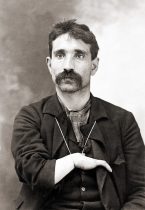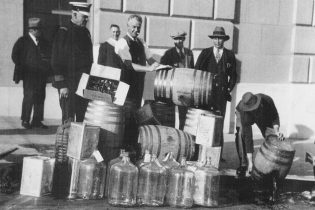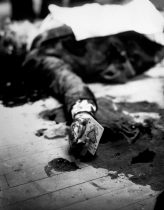Prohibition was a landmark era in the history of American crime- it is not only where we get our romanticized image of the pinstripe clad Depression-era mobster, but also where household names such as Capone gained notoriety. As bootlegging and alcohol-smuggling became the business of organized crime, New York City became one of the key centers of these transforming groups, and few events are as significant in the transformation of organized crime in America as the Castellammarese War. Today, the FBI recognizes the events of the Castellammarese War as pivotal in the transformation of Italian gangs in New York from a group of divided criminal factions into an organized, powerful crime syndicate run with corporate efficiency envisioned by its founder Charles Luciano, known since the 1930s as La Cosa Nostra, or the American Mafia.[1]
The name “Castellammarese” comes from the town of Castellammare del Golfo, on the island of Sicily. It was the birthplace of Salvatore Maranzano, one of the most powerful bosses of Cosa Nostra– the Sicilian Mafia- in New York. With its many ethnic groups, large population, and economic status, New York City had become the center for organized crime in the United States over the late 19th and early 20th centuries. Among its most prominent groups were the Irish Mob, Jewish gangsters, and the Italian Mafia. While each were distinct and membership was drawn among ethnic lines, both Irish, Italian, and Jewish gangsters play significant roles in the story of the Castellammarese War. In 1930, the Italian Mafia in New York was divided. On one side was the Mafia led by Giuseppe “Joe” Masseria. His sect was composed not only of Sicilian mobsters, but also members from other regions of southern Italy.

On the other side was Vito Ferro, a Cosa Nostra don who had gained a legendary status in the American Mafia after joining the Morello Gang headed by Giuseppe Morello and founded in Harlem at the turn of the century, which is today recognized as one of the first Italian crime families in the United States. In order to understand the circumstances which led to the Castellammarese War and a radical turning point in the history of American organized crime, we must start with the Morello Gang at the turn of the century.
Now, 1900 is quite a time away from 1930, but this early period in the history of Italian American organized crime is important. Vito Ferro was an early prominent member of the family, but left the United States in 1904 after a prominent murder for which his arrest was ordered by the New York City Police. He rose through the ranks of the mafia in Sicily, and would be the one to direct boss Salvatore Maranzano to build the Sicilian Mafia’s business in the United States to the point where it could take control over all Italian Mafia operations in the country.[2] Though Ferro was a legendary mobster originating in the Morello Gang, he would not be the last. By 1916, the Morello family had established the mafia, using the

Sicilian term, and was one of two major Italian American crime groups in New York City. While they were based out of Manhattan, they opposed a group called the Camorra, a loose association of Italian gangs from Brooklyn whose members originated from the region of Campania in Italy. These two groups would go against each other in New York City’s first mafia war, from 1915 to 1917, and it was here that the Morello family would see another prominent mobster cut his teeth- Joe Masseria.
Masseria already had a reputation by the start of the Mafia-Camorra war. After being released from prison in 1916, he became a high-ranking member of the Morello family and participated in their struggle against the Camorra. After arrests and convictions for the murders of several Mafia members led to the collapse of the Camorra, the imprisonment of

Giuseppe Morello and Ignazio Lupo meant that one of their captains, Salvatore D’Aquila, had become boss of the Mafia in Manhattan in their absence. He ordered their murders, along with ordering a hit on Masseria who had by this point become a powerful ally of Morello and Lupo. The hits on all three men failed, thus starting a war between Masseria, Morello, and Lupo on one side and D’Aquila on the other, effectively splitting into two families- the Morello family and the D’Aquila family. The war ended in 1922, with Masseria becoming the boss of the Morello family and thus the head of one of the largest Italian American crime organization in America.
Many former members of the Camorra joined the Morello family, meaning that the formerly Sicilian outfit had members from across Southern Italy in its ranks. Among those new members inducted by Masseria into his group during the war was one Charles “Lucky” Luciano. Although born in Sicily, Luciano had never been a part of the Sicilian Mafia, which by the mid-1920s was growing in power under Maranzano. Rather, Luciano had grown up in the Five Points neighborhood after his family immigrated from Sicily and spent

his time in the Lower East Side. It was here that he would meet a boy named Meyer Lansky, a Jewish immigrant from Russia, and through him another Jewish boy from Brooklyn named Benjamin “Bugsy” Siegel. As all three got older, they each went into respective crime groups- Luciano joined Masseria’s outfit while Lansky and Siegel joined the Jewish Mob.
Though a member of Masseria’s family, Luciano worked closely with the head of the Jewish Mob in New York City, Arnold Rothstein, as well as his old friend Lansky. Alongside Vito Genovese and Frank Costello, both future mafia bosses and the latter an influential figure in Tammany Hall, he helped pioneer bootlegging operations in New York for the Mafia under the guidance of Rothstein making millions of dollars a year, perhaps the largest bootlegging operation by any organization up to that point.
By 1929, a similar situation to that in 1915 had formed. Masseria had developed a strong rivalry with the Castellammarese family, or Castellammarese clan, headed by Maranzano. This led to the outbreak of the Castellammarese War in 1930.
According to most sources, the war began on February 26, 1930 with the murder of Gaetano Reina. Reina was the head of a smaller but prominent crime family which controlled parts of the Bronx and Harlem, controlled ice rackets (businesses which distributed ice as a laundering scheme and front), and had split off from the Morello family when Masseria and D’Aquila began their conflict. However, up to that point, he had been an ally for Masseria, and following his murder by Vito Genovese (who Masseria appointed to do the hit) Reina was replaced by a man named Joseph Pinzolo to control the ice rackets for Masseria. The next round in the war came in August, when Reina family gunmen loyal to the Castellammarese family killed Giuseppe Morello, the former boss of the Morello family. Two weeks later they subsequently killed Joseph Pinzolo in Times Square. In October, Masseria ordered a successful hit on Joe Aiello, an ally of the Castellammarese who led a Sicilian political group in Chicago. Maranzano retaliated in November by killing Manfredi Mineo, the head of a Masseria-allied gang, and a Masseria lieutenant on the same day.
As the war turned towards the Castellammarese, with Masseria on the backfoot, it showed the relative fragility of family loyalty for many lower ranking gang members. Many members of Masseria’s organization defected to join the Castellammarese, blurring the lines the war had originally been drawn along. But even as the two bosses traded blows, there was a second conflict brewing.

Both Maranzano and Masseria were considered “Mustache Petes”- old world Sicilian bosses who did things very traditionally. They often refused to do business with non-Italians, and looked down on non-Sicilian members of their organizations. This contrasted with the new generation of mobsters like Charlie Luciano, Vito Genovese, Frank Costello, and Tommy Lucchese who had largely grown up in America and saw these old world ways as unnecessary and stifling their potential for growth.
This led to Luciano’s faction- the new generation- to begin negotiating in secret with Maranzano. As part of Masseria’s organization, they believed that even if he won the conflict that Masseria would be unable to grow the organization further. Thus, they plotted to remove Masseria and install Luciano in place as head of the Mafia under Maranzano’s faction.

Joe Masseria was murdered on April 15, 1931, at the Nuova Villa Tammaro. It was found at 2715 West 15th Street in Coney Island. There he met with Luciano for lunch and drinks. Luciano left the table to go to the bathroom, and subsequently four trigger men entered the restaurant and shot Masseria in the back at least five times (the amount noted on his autopsy report). The men involved in the shooting were, by most accounts: Vito Genovese, Bugsy Siegel, Joe Adonis, and Albert Anastasia.[3][4] Of these, Genovese and Siegel were known to be close associates of Luciano. Masseria’s death put an end to the war, but it did not put an end to the story of what happened. The restaurant was closed after the murder of its owner in 1932 and today is a warehouse for a smoked-fish company.
With Masseria out of the picture, Maranzano had no one to stand in his way. Luciano took control of Masseria’s organization, giving birth to the Luciano crime family, with support from Maranzano. After this, Maranzano invited other bosses from across the country to New York and held a meeting at a resort hotel in Wappingers Falls. This meeting included other famous figures such as Al Capone, who by 1931 had served as the boss of the Chicago Outfit for years. But with New York City as the leading city for Mafia power, Maranzano asserted dominance over not just New York City but his dominance over all
other bosses, giving rise to the title capo di tutti capi, meaning ‘boss of bosses’.[5] With his newfound power, Maranzano initiated a reform of the Mafia in New York. He began to introduce a more organized structure and forced Sicilian rules over all Families in New York. Believing that Luciano was too ambitious, Maranzano organized a hit on him and Genovese.

However, Luciano was tipped off by Maranzano’s lieutenant, Tommy Lucchese, and was also told that Maranzano was expecting to be audited by the federal government due to tax issues. Luciano quickly ordered a group of hit men provided by Meyer Lansky and Bugsy Siegel to impersonate as police and kill Maranzano in his office at 230 Park Avenue in Manhattan. [6] This succeeded, and four Jewish mobsters dressed as police officers shot and stabbed Maranzano on September 10, 1931. The building is still there and is known today as the Helmsley Building, with Maranzano’s office having been on the ninth floor.
This fully ended the era of the Castellammarese War. After Maranzano’s death, Luciano called a meeting in Chicago of Mafia bosses from across the country, where he would establish “The Commission”. It organized the major crime families of the United States into a single organization, overseen by a board with a chairman. It established the Five Families of New York City; the Luciano, Bonanno, Profaci, Mangano, and Gagliano crime families (which are today known as the Genovese, Bonanno, Colombo, Gambino, and Lucchese crime families), as well as the La Costra Nostra as a national organization comprising the Five Families of New York City, the Buffalo crime family, and the Chicago Outfit that together oversee practically all Italian-American Mafia operations in the country.
[1] Federal Bureau of Investigation. n.d. History of La Cosa Nostra. Accessed March 30, 2020. https://www.fbi.gov/investigate/organized-crime/history-of-la-cosa-nostra.
[2] Sifakis, Carl. 2010. The Mafia Encyclopedia. New York: Facts on File.
[3] Gosch, Martin, and Richard Hammer. 1975. The Laste Testament of Lucky Luciano: The Mafia Story in His Own Words. Boston: Little, Brown & Co.
[4] Pollak, Michael. 2012. New York Times: Coney Island’s Big Hit. 29 June. Accessed March 29, 2020. https://www.nytimes.com/2012/07/01/nyregion/answer-to-a-question-about-a-mobsters-death-in-coney-island.html?_r=0.
[5] Raab, Selwyn. 2005. Five Families: The Rise, Decline, and Resurgence of America’s Most Powerful Mafia Empires. New York : Thomas Dunne Books. 29
[6] Buchanan, Edna. 1998. Time- Lucky Luciano: Criminal Mastermind. December 7. Accessed March 30, 2020. http://content.time.com/time/magazine/article/0,9171,989779,00.html.

3 probable sources of the term “MAFIA”.
1) It came from the abbreviation of the name of a group trying to drive the French out of Sicily. “Death to France is Italy’s Cry”. The kingdom of Sicily included a section of the lower part of the boot of Italy.
2) Mafia is a corruption of an Arabic word for gentleman or a man of honor. A mafioso and I am not positive I am spelling it correctly.
3) It comes from the Italian “my daughter”. Organized crime uses a very medieval format. A trickle up theory of economics and serfs. Serfs worked the land but in return got protection from the guy at the top. The guy who owned the land. The serfs took a piece of whatever was being grown and handed up the rest to someone else who took a piece for themselves and handed the rest up the chain. Trickle up economics.
During one of the many occupations of Sicily over the centuries, a soldier from an occupying horde came up on a mother and daughter working in a field. The soldier decided to have his way with the daughter. The mother began to scream “my daughter”. In Italian “ma fia”. Someone who worked for the land owner heard the screaming and ultimately killed the invading soldier. That is part of the deal. You pay up, you get protection. It is insurance that nothing bad will happen to you and your family from outsiders.
What were the names of the original five families that the word mafia comes from the first letter of each of the names of the five families start with M A F I A and that is how they got the word Mafia
That photo isn’t of Salvatore Maranzano. It is a gangster named Messina. Huge error that just won’t seem to go away.